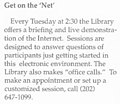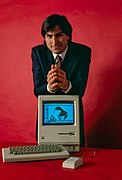Portal:Internet
The Internet PortalSelected article
YouTube is a video sharing website where users can upload, view and share video clips. YouTube was created in mid-February 2005 by three former PayPal employees. The San Bruno-based service uses Adobe Flash technology to display a wide variety of video content, including movie clips, TV clips and music videos, as well as amateur content such as videoblogging and short original videos. In October 2006, Google Inc. announced that it had reached a deal to acquire the company for US$1.65 billion in Google stock. The deal closed on November 13, 2006. Unregistered users can watch most videos on the site, while registered users are permitted to upload an unlimited number of videos. Some videos are available only to users of age 18 or older (e.g. videos containing potentially offensive content). The uploading of pornography or videos containing nudity is prohibited. Related videos, determined by title and tags, appear onscreen to the right of a given video. In YouTube's second year, functions were added to enhance user ability to post video 'responses' and subscribe to content feeds. Few statistics are publicly available regarding the number of videos on YouTube. However, in July 2006 the company revealed that more than 100 million videos were being watched every day, and 2.5 billion videos were watched in June 2006.
Selected picture The iPhone is a multimedia, Internet-enabled mobile phone designed and marketed by Apple Inc. It has a multi-touch screen with virtual keyboard and buttons. The iPhone was introduced, first in the United States on June 29, 2007 with much media frenzy and then in the United Kingdom, Germany and France in November 2007. It was named Time magazine's Invention of the Year in 2007. News
Wikinews Internet portal
WikiProjects
Did you know (auto-generated) -
Selected biography
Jonathan Bruce Postel (6 August 1943 – 16 October 1998) made many significant contributions to the development of the Internet, particularly in the area of standards. He is principally known for being the Editor of the Request for Comment (RFC) document series, and for serving as the Internet Assigned Numbers Authority until his death. While studying at UCLA, he was involved in early work on the ARPANET; he later moved to the Information Sciences Institute at the University of Southern California, where he spent the rest of his career. Postel served on the Internet Architecture Board and its predecessors for many years. He was the original and long-time .us Top-Level Domain administrator. He also managed the Los Nettos Network. The Internet Society's Postel Award is named in his honor, as is the Postel Center at Information Sciences Institute.
General images -The following are images from various internet-related articles on Wikipedia.
Selected quoteMore Did you know...
Main topics
Featured contentCategoriesRelated portalsThings you can do
Associated WikimediaThe following Wikimedia Foundation sister projects provide more on this subject:
Wikipedia's portals |






















































